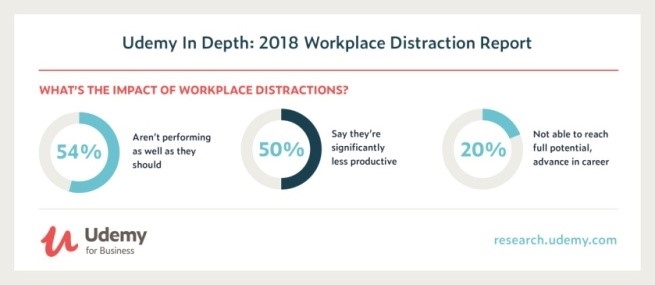— August 21, 2019
Since the recent past, we have been thinking of open floor plans as a tool to inspire collaboration and communication in the workspace. What is an ‘open floor plan,’ one might ask? We may define it as being a generic term used in architectural and interior design. This can be any floor plan which makes use of large and open spaces. It minimizes the use of small, enclosed rooms such as private offices. However, companies are coming to recognize what employees have known for a long time. That is, open floor plans actually reduce productivity. We believe that meaningful work requires acute focus and concentration. Karen Lachtanski makes a great case for the need for ‘remote working.’
Distractions Derail Productivity

We realize that knowledge-based activities such as writing and software coding need high concentration. We can cite the example of Lachtanski, who had worked for a small startup company where a cowbell was rung to celebrate every time it secured a big order. While we cannot deny that it was a great team motivator, problems were swift to come to the surface. And especially so when one of their web developers asserted it to be detrimental to his ability to concentrate. According to him, it took him about 30 minutes to refocus after the interruption.
To corroborate this, we can look at the research undertaken by the University of California, Irvine. The study shows that it takes an average of 25 minutes to return to a task after a distraction. This compels us to take a moment to think about how many distractions we face in a day. When we consider how many people are wearing headphones in the office, we can guess its effects on collaboration and communication.
For many of us, working away from the office, whether at home or in a quiet place, is steadily becoming the norm. In fact, many companies and individuals are participating in a Global Work from Home day on April 10.
How to Convince Your Manager Remote Work Is Necessary and Better
We feel that, sometimes, the benefits of remote work aren’t immediately evident to managers or the higher-ups. Below we have put forward a few recommendations to make its case.
- We should frame the conversation with the benefit in mind. We need to make it clear that we want to provide quality work and need a quiet space to do our best work.
- We have realized that the offer to work remotely on a trial basis (one or two days a week) works wonders at getting the conversation started. The trial period is to prove that we can be more productive than our peers. We can achieve this while working from home by setting evaluation dates and defining what success should look like. Supervisors are left to consider the utilities and the value of the service provided in their own terms.
- We should discuss the collaboration tools which we will use to stay in touch with our manager, the team, and others.
- We find that communication is of the greatest importance to prove that we can be trusted to do the work. Communicating what we have accomplished can be very helpful. It is valuable to have similar projects that were completed in the office as examples to compare to.
- We should establish the working hours if they are different than normal office hours. We stress the need for transparency and diligence in attendance. Proper steps should be taken to ensure rewards, as is stated in this post by Morzaria.
We find that it is necessary that we explain our remote office situation. We need to clarify if it is at home or in a co-shared space. We should discuss how we will handle company materials and assets in a responsible and secure way. To be efficient, we need to share pictures of what our workspace would look like.

We agree that remote working might not be right for everyone. Yet, we believe that when it is, everyone wins in one shape or form. And we do feel that it a valid concern for most managers to wonder if allowing remote work for one person means it should be allowed for everyone. There are many reasons why working from home is not viable for everyone.
In the present day, we discover that graduates, when entering the workforce, are looking for alternative work styles. At the same time, retaining talent and hiring the best talent is a growing concern for companies. This means they are looking at ways to change the office workplace.
We do recognize the difficulty of the older companies for whom accommodating work from home requests can be a major shift from what they had been doing earlier. There can be situations where managers may not have the discretion to say yes even to a trial. In such cases, we advise the discussion of the proposal to be shifted to the HR and other managers. It is incredibly helpful if one’s company views them as a valued employee who contributes in a professional way. In companies where remote working is a new concept, it is trust which forms the basis for the realization of the concept. For instance, when one needs a doctor’s appointment, we advise doing so near the end of the day. The employee should work from home instead of returning to the office. We find that it is crucial to talk about what we were able to accomplish during that time at home and suggest doing it more often.
One’s manager can be the kind who wants to see concrete data. In the case of such scenarios, we suggest showing them the research mentioned earlier along with the results of a 2-year Stanford study by professor Nicholas Bloom. This TEDx talk in 2017 shows the remote workers’ productivity and longevity in terms of working hours, with their employee attrition being 50 percent less than telecommuters. Additionally, the company benefited from needing less office space. Further ways to effectively combat employee turnover or churn rate is discussed in depth in this article.
Finally, we cannot fathom how one can override the benefits of an employee who worked longer, was more productive, and was less likely to leave. As a matter of fact, remote working is surely and steadily becoming the norm. Eventually, we will find that requesting the need for it will no longer need negotiating with such detail.
Business & Finance Articles on Business 2 Community
(52)
Report Post





